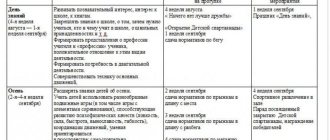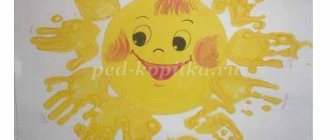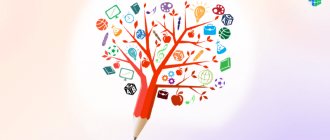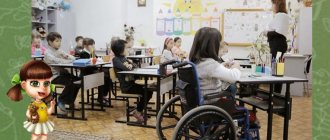MAGAZINE Preschooler.RF
Project: “What is energy saving?” in the pre-school group.Type of project: educational and research
Project implementation period: short-term.
Project participants: children of the preparatory group, teachers, parents of students.
Relevance of the project
The economical use of energy is the main problem for all of humanity, since its production requires a lot of natural resources (water, forests, minerals). The result is a negative impact on the environment. All these factors lead to the conclusion that it is wiser to reduce energy consumption rather than constantly increase its production.
Problem
If we constantly increase capacity to generate more electricity and at the same time we need to cut down more forests, extract more oil, gas and coal, block more rivers for the construction of hydroelectric power stations, will we be able to protect our nature from destruction? What do we need to do? How to learn to save energy resources?
Expected result.
Laying the foundation for a careful attitude towards energy resources and fostering an elementary culture of energy saving.
Formation of an idea of the relationship between human activity and the environment.
The goal of the project: to create conditions for the formation in children of the fundamentals of a careful attitude towards the use of electricity and the education of an elementary culture of energy saving through the cognitive activities of children.
Project objectives:
For children
- Introduce children to different types of energy.
- To form in preschoolers ideas about electricity, where it “lives” , how it gets into homes and is used by people.
- To acquaint children with the past and present of lighting devices, with the process of their transformation by man.
- Establish rules for safe handling of electrical
devices.
6. Instill in children a careful attitude towards energy resources, based on the initial skills of their rational use.
For teachers:
- Increase the level of professional competence, enrich knowledge on current issues of energy saving.
- Strengthen the skills of organizing project activities with preschool children.
- Create conditions for familiarizing pupils with energy resources through enriching the subject-developmental environment and a system of activities with pupils and their parents
For parents
- To promote interest in the content of energy-saving work with children and participation in joint events.
- Increase the pedagogical competence of parents, enrich their educational experience, and promote the harmonization of parent-child relationships.
- Replenish knowledge on energy saving, be more responsible about the consumption of energy resources.
Immersion in the project
1. Creating a problem situation: I invite the children to dance to musical accompaniment as a warm-up. I turn on the tape recorder (not connected to the mains), it does not work.
Question for children: What happened? Why doesn't the tape recorder work?
I invite children to formulate a new topic for knowledge, what questions interest them, and where they can be answered, using the model of three questions (What do we know? What do we want to know? What do we need to do to find out?).
Project work planning:
Activities of the teacher:
Studying literature on the topic of the project.
Development of the project structure, thematic planning of all types of children's activities.
Selection of illustrative material, didactic games.
Discussion with parents of issues related to the implementation of projects.
Involving kindergarten staff to participate in the project.
Parents' activities:
Participation in a survey on the topic: “Do you know how to save energy?”
Studying literature on the topic of the project, selecting illustrative material.
Discussion of issues related to the implementation of projects.
Carrying out activities at home aimed at saving water, heat and electricity.
Carrying out observations for 3 days - how many liters of water and electricity can be saved if you follow the rules of economy and make a comparative analysis with normal (uneconomical) consumption.
Children's activities:
Conversations on the topic:
- “What do we know about electricity? Main sources of electricity"
- "Electrical devices and their purpose"
- Rules for safe behavior “Caution! Electricity!"
- “What is energy saving, how can you save energy resources?”
Experimentation on the topic: “Static electricity”
- "Revived Hair"
- "Magic Ball"
- "Magic Wands"
Observation: “Where does electric current live in kindergarten?”
Examination of illustrations: “Household appliances: ancient and modern .
Didactic games: “Good and bad”
“Household appliances – ancient and modern”
“Riddles and guesses about electrical appliances”
Drawing.
- "Electrical household appliances"
- "Reminders for energy saving"
Reading fiction
- Author's fairy tale “Majesty-Electricity” (Eliseeva Yana)
- Poetry:
“He Runs on a Wire” Yakov Byl
“There is a corner in the apartment” Vedenyatina Nadezhda
3. Fairy tale: “How the sun lit an electric light bulb” Zhilinsky I.M.
Project product
The result of children's activities:
Design of the exhibition of drawings “Household Electrical Appliances”
Design of the collage “Energoshi’s Tips”
Carrying out promotions for kindergarten employees:
Dissemination of warning signs to conserve energy resources
For parents - Design of the transport information folder: “Electricity saving. Water saving. Heat saving" .
Distribution of leaflets “How to save energy. Warmth and water?
Results obtained for the project.
Children learned the rules for safe handling of electrical
devices.
Children's horizons about energy resources and the culture of energy saving have expanded.
Children have developed energy-saving behavior skills in kindergarten and at home;
ideas about the relationship between human activity and the environment have been formed.
Parents analyzed the benefits and benefits of economical consumption of electricity, water, heat and decided to follow energy saving rules at home and at work.
The kindergarten employees actively took part in the energy saving campaign.
Porotova Vera Petrovna
Teacher at MDOU kindergarten No. 50. Ust-Kut, Irkutsk region.
| Next > |
Project “Lean Kindergarten” (kaizen technologies in preschool educational institutions)
Author: Kezhaeva Ulyana Olegovna
teacher of MBDOU No. 45, Odintsovo
Project “Lean Kindergarten” (kaizen technologies in preschool educational institutions)
Project
“Lean Kindergarten” (kaizen technologies in preschool educational institutions)
Modern preschoolers live in the 21st century - the century of complex social and economic relations. The future will require them to be able to navigate correctly in various life situations, to act independently and creatively, and therefore to build their lives in a more organized, reasonable, and interesting way. Such a quality as frugality not only brings the child closer to real life, teaching him to navigate what is happening, but also develops the business qualities of the individual, and develops skills in rational environmental management.
Today's preschoolers are not interested in ready-made answers to questions, standard solutions, or the edifications of adults. The fidgets that everyone can now find on the Internet require a special approach to help them quickly adapt to a changing world, develop innovative thinking and creative abilities that are inherent in every child at birth.
Kaizen methods and tools turned out to be understandable and accessible in the practical activities of kindergartens. "Kaizen" (kaizen) is translated as "improvement" (from "kai" - "change" and "zen" (tsen) - "good").
Significant role
In the development of kaizen technology by children, it is the responsibility of educators. They are the ones who work with children to teach various kaizen tools. Moreover, the teachers themselves do not provide children with ready-made information about what this or that instrument is intended for. The children make their own assumptions about their purpose. Thus, at the same time, the tasks of activating children’s non-standard thinking, the ability to independently find solutions and build logical connections are solved.
The Kaizen philosophy suggests that our way of life, be it work, social or family life, deserves continuous improvement.
This prompted us to actively work in this area in close cooperation with the students’ parents. The main emphasis was placed on the daily life of children, in all types of children's activities.
Target
— to form ideas about thrift among children of middle preschool age based on the use of the project method.
Tasks:
- Analyze psychological and pedagogical literature on the issue
formation of the foundations of frugality in preschool children.
- Create conditions conducive to the formation of frugality in
preschoolers.
- Develop thematic projects on the identified problem.
- To develop children’s innovative thinking, the ability to independently find solutions and build logical connections.
- To test in practice modern approaches to organizing the educational process, designed to ensure the formation of the foundations of frugality among older preschoolers.
- To intensify forms of cooperation with parents of pupils to form the foundations of frugality in preschoolers.
Based on the experience of the educational holding “Childhood without Borders ,” we developed specific activities, namely:
1. application
of visualization
aimed at increasing the safety of children, parents and employees.
In the course of solving this problem, signs, pointers, inscriptions on cabinets, etc. appeared in the kindergarten;2 . standardization
of daily operations;3.
organization of
workplaces and space.
Estimated results of the project implementation.
During the implementation of this project, children will be able to acquire basic knowledge about ways to save (time, water, heat), develop initiative and independence in cognitive and research activities, and develop curiosity (experimentation, experiments).
| Stage | Contents of the activity | Deadlines |
| Search | Preparatory stage | September 2019 |
| Analytical | Preparatory stage | October 2019 |
| Practical | Main stage | October-April 19/20 |
| Presentation | The final stage | April-May 2020 |
| Control | The final stage | May 2020 |
Preparatory stage (search and analytical):
-studying materials on the topic in Internet sources;
- setting goals and objectives, determining relevance and results.
-preparation of consultations for parents;
-development of conversations for preschoolers.
— preparation of illustrations and multimedia presentations for classes
Main stage (practical)
:
1. Familiarization with the content of Kaizen technology
- Preparation of information materials about Kaizen technology (messages, conversations, presentations).
3. Seminar for preschool teachers “Life in the Kaizen style”
- Direct work with children during the project implementation
Forms of work with children during the implementation of the project in the middle group:
-conversations (for example: “If you need to put things away, you won’t have to look for them”)
-reading fairy tales and stories;
-thematic games-activities: “Lessons of the Sorceress of Nature”, “How to keep water clean”, “How to keep warm”, others.
-discussion of problem situations
-inclusion of children in educational and practical activities,
conducting experiments and experiments;
-organization of thematic role-playing games;
— compilation of the “ABC of Thrift”
— a series of classes and conversations “Energy saving is a matter for everyone, benefits for everyone”
- the use of signs, reminders and roller symbols in the subject-spatial environment (allows you to quickly put toys and attributes in their place, prepare for educational activities). Signs are used in group blocks
which help improve the safety of children, and also teach children to conserve resources (water, light, heat).
Forms of interaction with family:
- writing stories with children “How we save heat, water and light at home”
—
participation in organizing the environment on the topic of the project - making attributes for classes and observations.
— consultation for parents “Order is the key to responsibility, cleanliness and frugality.”
-Joint drawings on the project topic
Final stage (presentation, control)
:
1. Monitoring the results of the activities of project participants.
2. Design of the exhibition of drawings “Thrifty kindergarten”.
- Creation of virtual information corners and consultations for parents “Save water!”, “Let’s keep warm!”
3.Preparing a report on the work done.
Theory and practice of holding a group meeting
In the broadest sense, the morning group meeting is intended to provide the opportunity for constructive, cognitive and business development of children in a situation of natural socio-emotional communication with peers and adults, to develop skills in understanding themselves and others, coordinating the purposeful activities of the entire group and each individual .
Pedagogical objectives are formulated based on the general meaning of the group gathering:
- create a positive emotional mood for the whole day - “set the tone”;
- provide conditions for interpersonal and cognitive-business communication between children and adults;
- activate children's skills related to communication, planning and organizing their own activities;
- choose a topic for a new project together with the children;
- develop a plan for the implementation of a new project;
- summarize the project;
- develop empathy;
- instill communication culture skills (greetings, compliments, etc.);
- learn:
- – formulate judgments, give reasons for statements, defend your point of view;
- – select the most significant, interesting events from personal experience, talk about them briefly, but consistently and logically;
- – listen carefully, show a constructive attitude towards the statements of others;
- – explain your emotional state in words and correct it;
- - make a choice;
- – plan your own activities;
- support the desire to agree on joint activities, distribute roles and responsibilities.
The role of the teacher in a group gathering
The role of the educator is to:
- ensure comfortable and constructive participation of all children in general conversation, play, and planning;
- establish and maintain a cultural framework (help children master culturally and situationally appropriate styles of behavior and communication, a culture of dialogue and monologue);
- demonstrate your own pedagogical and personal attitude to the statements and ideas of children, without imposing it;
- stimulate and support children’s initiatives regarding the choice of topics, content, materials, forms and methods of action;
- offer children their ideas on content, types of activities, interest children and thereby solve educational problems using the material that is relevant to them;
- help children choose and plan work;
- provide support to all children, including those with special educational needs.
Group fee structure
In its most general form, the structure of a group collection looks like this:
- Greetings (option: wishes, compliments, gifts) …………….
1–3 min - Game (option: elements of training, psycho-gymnastics, singing, listening) 2–5 min
- Exchange of news …………………………………………………………………………………
2—10 min - Planning the day (selecting a project topic, planning content, forms and activities for the entire project); presentation of Activity Centers (adults and children) ………………….
5-12 min
Thus, the total duration of a group meeting ranges from 10 to 30 minutes. There is no rigid frame, just as there is no rigidly fixed structure. The total time and the time of individual parts of the collection are flexible and depend not only on the age group, but also on what goals are being pursued, in what tone and pace the communication takes place, how well everyone is buried together, how well adults (educators, parents, specialists) conduct the collection lively and it’s funny how interesting and important the topic being discussed is.
There may be options when the greeting is very short, there is no game at all, and exchanging news or planning takes up most of the time.
A series of classes and conversations “Energy saving is a matter for everyone, benefits for everyone”
During the implementation of the practical stage of the project, a course of creative activities was also conducted with children within the framework of “Kaizen Technologies” on the topic “Energy saving is a matter for everyone, a benefit for everyone.”
The purpose of this “inclusion” was to generate initial information about the rational use of natural resources, basic safety rules and energy saving.
Tasks:
- to form in preschoolers ideas about electricity, where it “lives”, how it gets into homes and is used by people;
- develop the desire for search and cognitive activity, mental activity and creative abilities;
- develop environmentally sustainable and safe lifestyle skills; respect for nature, electricity and heat;
- develop communication skills;
- involve preschoolers in useful activities for energy and resource conservation.
The problem of reasonable use of energy is one of the main problems of humanity. Energy saving is not only about saving money, but also about caring for the Planet. Each of us is part of the Planet, so any of our actions or inactions can affect the development of events. Energy saving is very important for how we live on this Planet and our descendants! During the implementation of the project, we wanted to remind children of the simplest methods of saving electricity, heat, and water. Explain how you can save energy resources in kindergarten and at home, what role energy saving plays in preserving the Earth's ecology, and what rules everyone must follow in order to save natural resources. Only targeted work on instilling in preschoolers a culture of resource and energy conservation will bear fruit in the adult lives of today’s children; they will not be wasteful, let them become active helpers of public initiatives aimed at preserving and increasing the resources of our country.
Preliminary work:
daily observations of various phenomena of the surrounding world; conversations about water, air, electricity, natural resources; viewing and reading children's encyclopedias; didactic games “Light, water, sound”, “Basics of safety”, “My home”, experiments and experiments with water, air, light.
Practical stage of implementation of the cycle “Energy saving is a matter for everyone, benefits for everyone ”:
- initial analysis of scientific literature on the topic “Energy saving”
- parent survey “Do you know how to save energy?”
- the main cycle of classes on the educational block “Energy Saving”.
- conversations “Smart human assistants”, “Energy around us”, “Electricity in nature (lightning)”, “Living and inanimate nature”, etc.
- viewing a multimedia presentation “Energy Saving”;
- reading fiction: “The Tale of Lost Heat” by I. Bashmakova, Dvoretskaya Zh.G. , Sitnikova I.A. “Children’s trip around the country “Thrift”, etc.
- NOD “ABC Beregoshi” Entertainment “The Counter Visiting the Guys” III.
Planned results:
after completing the cycle
“Energy saving is a matter for everyone, benefits for everyone”:
Children:
notice the beauty of the surrounding nature and strive to preserve it; they know that our planet is a common home for people, animals, plants; can tell at a level accessible to them what role light, heat, clean air, water, soil play in the life of humans, animals, and plants; know that the Earth's resources are not endless, they are difficult to restore; are competent consumers of water and energy resources, ask adults about this; feel proud of the benefits they bring to their family and society.
Teachers:
have knowledge on current issues of energy saving; exchange positive experiences in organizing work with children and parents on energy saving; in collaboration with children, they save electricity, water, and heat in their workplace, thereby providing assistance to the kindergarten, district and city.
Parents:
expand their knowledge of energy saving and conserve energy resources to benefit the family budget; show creativity by participating in environmental holidays and events; are more responsible about the consumption of energy resources and water, strive for a positive assessment of their actions on the part of children; Working together with your child strengthens your relationship with him.
As a conclusion
At this stage, the tasks set by the implementation of this project have been completed for all categories of participants, in accordance with the goal of involvement in the process. Improvements through the use of technology have been implemented and results are already visible.
Due to the epidemiological situation, we consider it appropriate and the only possible way to complete our project this academic year in the form of a virtual exhibition of collective (together with parents) creative works on the topic of energy saving “Lean Kindergarten”. As well as the creation of information corners and virtual consultations for children and parents “Save water!”, “Let’s keep warm!” (rules for economical use of water, heat and electricity).
The work does not end at this stage, and will continue, because Kaizen is being introduced gradually and will take time, as it implies an endless pursuit of perfection with slow steps confidently forward!




